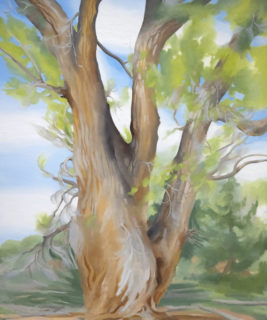Heather James presents a unique duo exhibition featuring the works of Georgia O’Keeffe and Marsden Hartley. This intimate show allows the viewer to see the development of Modernism in the United States by two of its most important artists. Although the two artists are not often linked, O’Keeffe and Hartley travelled in the same circles, figuratively and literally. They explored similar ideas and landscapes but with different interpretations, giving a wide breadth to American Modernist art.
ARTWORK
ABOUT
Marsden Hartley was born in 1877 in Maine. Hartley was one of the earliest painters in the U.S. to create almost completely abstract works. His travels to Europe and Mexico deepened his understanding of Modernism, giving him different contexts of developments within and outside the U.S. The paintings in exhibition showcase these international influences.
Hartley travelled to Europe in 1912 after his successful exhibition at 291 Gallery, founded by Alfred Stieglitz. There in Europe, he encountered the explosion of new ideas spreading across the continent. Gertrude Stein, who bought several of his works, the works of cubist Pablo Picasso, and the writings of Russian abstract artist Wassily Kandinsky were vital influences. The pieces in the exhibition show the clear effect these sources had as the canvases depict both abstract images and abstract themes. Like Kandinsky, Hartley sought to emulate the non-narrative, non-image-based structure of music to the canvas. In fact, these pieces were created around the same time as and shortly after Hartley’s landmark “Portrait of a German Officer” now in the Metropolitan Museum of Art in New York.
Georgia O’Keeffe was born in 1887 in Wisconsin. Few figures loom as large on the American psyche as O’Keeffe. Her famed paintings of flowers and the American Southwest has imprinted onto our vision of America and the different ways of seeing. Nevertheless, her paintings transcend national boundaries in their exploration of what it means to paint and what Modernism looks like.
While deeply associated with the American Southwest, O’Keeffe began her artistic career in New York. Her first exhibition was with her future husband Alfred Stieglitz in his 291 Gallery in 1916. O’Keeffe’s first visit to New Mexico, the state most tied to her, was in 1929. The environment would have a lasting impact on her work in its architecture, shapes, and color. The painting in the exhibition comes from the 1940s, a time in which O’Keeffe turned more and more to working in series. The work depicts a cottonwood tree in Abiquiú where her second home was located. The piece contains her characteristic vibrant color and forms of the Southwest.
But what ties O’Keeffe and Hartley? There is the obvious answer that they were both associated with Alfred Stieglitz through his gallery and their relationship with him. The gallery pushed Modernism to the forefront of the American art scene in its showcase of US born artists like O’Keeffe and Hartley but also in its introduction of European artists like Cezanne, Picasso, and Matisse. Stieglitz gave both O’Keeffe and Hartley their first exhibition and in his stable of artists, the two found a like-minded artistic circle including Arthur Dove and John Marin.
Both artists also found inspiration in New Mexico. Although he did not permanently move to the Southwestern state, Hartley travelled there to experience the unique nature of the United States and to forge a new path of American art – things that O’Keeffe would in turn do about a decade after. However, unlike O’Keeffe, Hartley would paint most of his New Mexico paintings from memory after his travels. The distinctive, expansive landscape layered with an idiosyncratic cultural history was a fertile field of inspiration for the artists. As previously noted, Hartley followed in the footsteps of Kandinsky to translate the qualities of music into a visual medium. Likewise, O’Keeffe was inspired by Kandinsky, particularly his 1912 text “Concerning the Spiritual in Art and Painting” which urged that synthesis of aural and visual arts. O’Keeffe was fascinated by synesthesia – the neurological condition in which stimulating one sense triggers a different sense. In the case of O’Keeffe, it was the translation of sound into sight. Many of her works would reflect this crossing.
This intimate exhibition shows a unique moment of development of Modernism as artists in the US explored new ways of thinking and painting, about what it means to be modern, and more deeply, what Modernism looks like in the United States.
ARTISTS
INQUIRE









